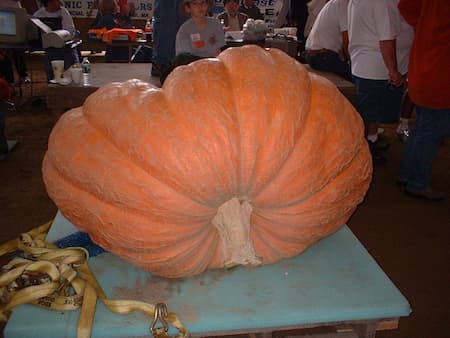
Most home gardeners who grow regular Jack O’Lantern sized pumpkins or miniature pumpkins. They never give pumpkin genetics a passing thought. However, when growing huge pumpkins to a monstrous size, growers are serious students of giant pumpkin genetics. Accordingly, they are acutely aware of the fact that pumpkin DNA plays a major role in the ultimate size of the fruit. There are three factors that determine how big the pumpkin ultimately becomes:
A pumpkin plant produces female flowers, which contain ovules (eggs). It also produces male flowers, which produce pollen (pollen). Reproduction in plants, like animals, involves the uniting of an egg and pollen to produce offspring. In the case of pumpkins, they produce seeds. Each pumpkin can produce many hundreds of seeds.
Each seed contains it’s own unique genetic code, which dictates all aspects of the future pumpkin’s potential growth. This code is called DNA. DNA is organized into genes. An individual gene controls one specific aspect of the pumpkin. One or more genes work together to form a trait. Color, size, and shape are considered traits. Keep in mind, we are talking about it’s “potential”.
Confused yet? Hopefully not, because it gets thicker yet. There are many variations to a gene, which are termed alleles. Alleles are what make us, and pumpkins, all unique. For example, green, orange, red, and yellow are all separate alleles for the “color” gene in pumpkin genetics.
When the pollen and the egg unite, they combine their DNA to form a complete seed. The pollen and the egg each contain one allele for every gene (there are thousands) in the pumpkin’s genome (all of an organism’s traits). When the two alleles combine, the plant has a way of deciding which of the two alleles will be used or “expressed”. This is termed dominance and recessiveness. A pollen or an egg can contain either a dominant or a recessive allele for any gene, depending on what the parent plant originally gave it. A dominant allele will in effect shut off the recessive allele, thereby allowing the dominant allele to be expressed.
Color is a little easier to explain than size. Many alleles control the size of the fruit. This includes volumization, cell number, cell size, growth rates, metabolism, and a host of other factors. In pumpkins, orange color is a dominant allele, and green color is a recessive allele. If the egg contains the orange allele and the pollen contains the green allele, the fruit expresses the orange color. This is because it is dominant over the recessive green allele. The only way to produce a green pumpkin is if both the egg and pollen contain the recessive green allele.
One final point to keep in mind is that the genetics of the pollen fertilizing the female flower have no effect on the growing pumpkin. The pumpkin DNA contained within the pollen passes on to the seed of the pumpkin. And, it shows up next year in the plant and fruit grown from that seed. Therefore, the traits exhibited by a growing pumpkin are the direct result of the female’s parents. When making a cross, you are actually preparing the genetics of the next generation of pumpkins!
If you have digested, and understood the previous paragraphs, congratulate yourself. Some of the concepts are hard to grasp, but in the end will pay off. Hopefully this will be the jumpstart you needed to dive into more complex issues concerning AG genetics and it does get much more complex than this!!
Mr. Joe Ailts of, Deer Park, Wisconsin contributed this article. Joe is a B.S. Biotechnology graduate from the University of Wisconsin-River Falls.
Also, people who like this article on giant pumpkin genetics will like:


